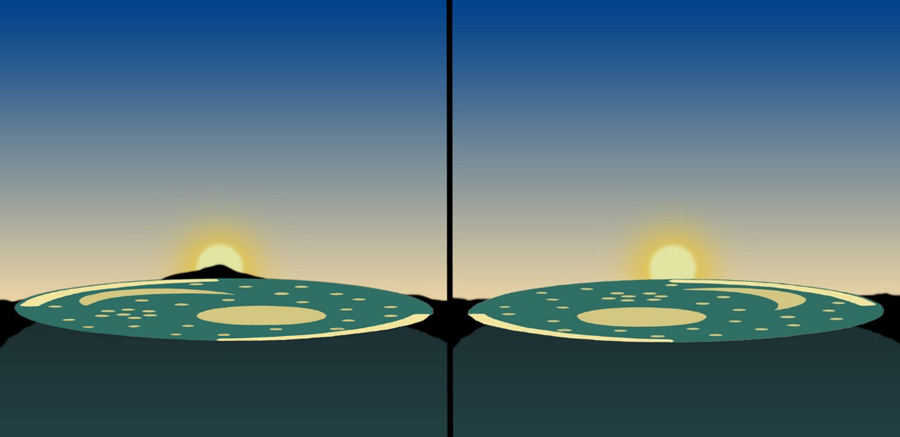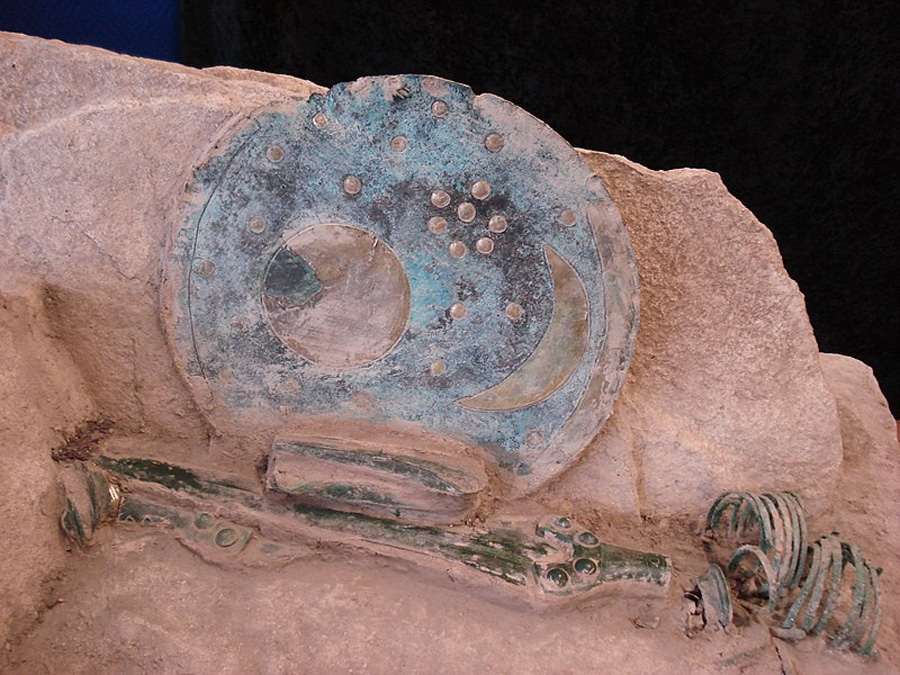The Nebra Sky Disc looks like it shouldn’t be real. This bronze disc, no more than 30 cm (12 inches) across) and covered in what appears to be a simplistic depiction of the night sky, seems like a crude fake, or a child’s toy. But researchers are agreed: this is one of the oldest and most fascinating portrayals of the heavens in existence.
The disc dates back to nearly 3,600 years ago and is believed to be the oldest attempt at an accurate depiction of the cosmos. Covered by a blue-green patina, the surface is embossed with symbols covered in gold representing the full Moon or the Sun, stars, and a lunar crescent.
The depictions may look primitive but there is evidence of keen observation and measurement on the artifact also. There are two golden arcs on the sides, which measure with surprising accuracy the differing angle of the night sky and sunrise between the summer and winter solstices.
Discovery of the Disc
The bronze disc was only discovered comparatively recently in the town of Nebra in Germany. Two treasure hunters named Mario Renner and Henry Westphal, hunting illegally with the use of a metal detector, found the disc in 1999.
The looters caused considerable damage to the disc while removing it. A large piece of the disc was chipped the outer rim was badly splintered, and one of the stars on the surface was lost.
After discovering the disc, the looters tried to sell it off to the local archaeologists along with two axes, two swords, fragments of armlets, and a chisel. However, under German law the disc belonged to the Sachsen-Anhalt state, and it was not allowed to be sold legally.
In February 2003, the looters again made an attempt to sell the object to Switzerland’s antiquities collector. But the collector collaborated with the Swiss police and the looters were arrested. Finally, the Nebra sky disc was where it belonged, in a museum.
Greeted with Skepticism
One of the most prominent questions that arose is relating to the archaeological context of the Nebra sky disc. As the object was discovered by the looters, there was no secure or solid archaeological surrounding to help understand the disc.
So, accurate dating of the object was quite challenging, especially given nothing like this had ever been found before. Carbon dating of the disc would mainly depend on objects found buried along with it.
This, along with the unusual appearance of the Nebra Sky Disc, led a lot of debate relating to its authenticity. Initially, it was even suspected that it could be just an archaeological forgery or a hoax. During the late 2004, soon after its recovery, the disc became a topic of controversy.
According to the claims of Professor Peter Schauer, a German archaeologist from the Regensburg University, the disc was a fake, and the claims of a Bronze Age map were nothing but fantasy. He also claimed that the green patina of the disc was created artificially with the use of a blowtorch, acid, and urine.
However, later it was discovered that Professor Peter Schauer never actually studied the ancient object. But the questions relating to the authenticity of the Nebra sky disc still remained.
The Disc is Dated
In order to determine the precise dating of the disc, the other Bronze Age weapons found along with the disc were dated. According to the findings, the swords and axes belonged to the mid-second millennium BC.
Birchbark particles recovered from the swords underwent radiocarbon dating testing. The results revealed that the finds belonged to the period between 1600 to 1560 BC and appeared to confirm the archaeologists’ suspicions that the disc was genuine.
Further solid evidence relating to the authenticity of the Nebra Sky Disc was given by Germany’s Halle Institute for Archaeological Research. A number of tests were conducted by the institute in order to confirm that the Nebra sky disc was indeed authentic.
The microphotography of the corrosion present on the disc produced several images that gave proof of the fact that the disc was a genuinely ancient artifact. It also showed that it was not possible to create the disc artificially.
- How Did The Dogon Tribe Know About Sirius B?
- “And Yet It Moves” – Galileo, the Planets, and the Church
Moreover, the latest examinations conducted by the German scholars in 2006 also proved that the Nebra sky disc was a genuine one. These researchers also concluded that the disc was used as an astronomical clock, for effectively synchronizing the lunar and solar calendars.
Significance of the Nebra Sky Disc
This remains only a theory however. The actual use of the Nebra Sky Disc is not known, although experts have made a number of assumptions relating to the possible application of the disc.
Some researchers believe that the disc works in a similar way to a sundial. According to this representation, the central circle on the disk denotes the sun.

The arcs found on the sides of the object may represent the extent of differing sunset positions at different times of the year, as observed from the Mittelberg Hill in Nebra, Germany, a prominent observation point near where the disc was found. The arcs would therefore show the range of positions of the moving sunset through the year.
Several others believe that it could be a type of astronomical calculational tool. It could be used as an advanced astronomical clock in order to determine the ideal time for harvesting and planting.
The Bronze Age people belonged to the agricultural society and this would certainly be a common and practical use for the disc. Such useful functionality is often seen built into ancient agrarian societies, with Stonehenge being a similar tool for keeping time through the year.
According to a professor of the University of Bochum, Wolfhard Schlosser, the Nebra Sky Disc could be an astronomical-astrological device. He believed that the arcs along the circumference of the disk were indeed used for depicting the solstices of the sun accurately at Mittelberg hill.
According to Wolfhard Schlosser, the current value of the Nebra sky disk could be worth nearly $11.2 million. The disc will be showcased in the British Museum in London as a part of the exhibition in 2022.
Top Image: The childish appearance of the disc belies the accurate measurements on its surface. Source: Dbachmann / CC BY-SA 3.0.
By Bipin Dimri
